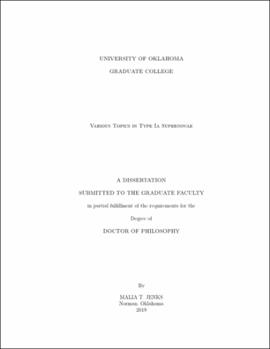| dc.contributor.advisor | Baron, Edward | |
| dc.contributor.author | Jenks, Malia | |
| dc.date.accessioned | 2019-05-10T21:30:27Z | |
| dc.date.available | 2019-05-10T21:30:27Z | |
| dc.date.issued | 2019-05-11 | |
| dc.identifier.uri | https://hdl.handle.net/11244/319726 | |
| dc.description.abstract | This work takes two approaches to increasing our understanding of type Ia supernovae. The first part uses observations to study their spectral evolution and diversity. The second part uses modeling to investigate a potential progenitor. We cannot yet explain all of the observed diversity of these objects that are and will continue to be important tools for understanding the universe. Our understanding of SN Ia is limited by not understanding the progenitor system or systems that produce the explosions and by an incomplete understanding of the physics of the explosion itself.
Through the use of 197 spectro-photometric time series spectra from the Nearby Supernova factory it is possible to measure the time evolution of spectral features in these objects. This unique data set allows us to look for new behaviors. We find two narrow wavelength regions that for some of the sample show a near constant flux over a period of several days. About half of the sample show this plateau behavior in the wavelength region from $6125$~\AA\ to $6200$~\AA\ around 20 days after maximum light, the rest of the sample show either no plateau or a slow linear decline in flux over the same time period. The groups that show either a plateau or linear decline can be separated from the objects not showing a plateau like behavior. The presence of this plateau feature are associated with a stronger secondary maximum in the $I$ and $R$ bands and higher absolute magnitudes. The other region found to show this plateau behavior occurs in the wavelength region between $6800$~\AA\ and $7000$~\AA\ about 20 days after maximum light. This plateau is a feature of most of the supernova in the sample. Using a set of existing PHOENIX synthetic spectral time series, we looked for the same behavior found in the observational data. From this model data we argue that the plateaus found in this work are likely related to the ionization behavior of Fe~II/Fe~III over time.
One proposed progenitor path of SNe~Ia is non-violently merging double white dwarf systems. There is some indication that the mass ratio of the merging system may result in different outcomes. This work takes the quasi-hydrostatic state output of a 3D spherical particle hydrodynamic (SPH) simulation of three different merging white dwarf systems and models the initial viscous evolution with FLASH, a hydrodynamic simulation code. The three merging systems start with varied mass ratios from 0.55 to 1. The FLASH code was run in 2.5D with a simplified magnetic field to supply viscosity for about 100 seconds with a grid spacing on the order of 10 km. This fine grid allows us to look for potential carbon ignition points in the relaxing merged system. We find that none of these mergers blow a substantial wind or show significant mass loss. We find heating on the interface between the lower mass outer region and the higher mass central star, as well as along the rotation axis in the central region. None of the heated regions reached carbon ignition conditions in the simulated time. | en_US |
| dc.language | en_US | en_US |
| dc.subject | Type Ia Supernova | en_US |
| dc.subject | Physics, Astronomy and Astrophysics. | en_US |
| dc.subject | Supernova | en_US |
| dc.title | Various Topics in Type Ia Supernovae | en_US |
| dc.contributor.committeeMember | Dai, Xinyu | |
| dc.contributor.committeeMember | Wisniewski, John | |
| dc.contributor.committeeMember | Kao, Chung | |
| dc.contributor.committeeMember | Cavallo, Steven | |
| dc.date.manuscript | 2019-05-09 | |
| dc.thesis.degree | Ph.D. | en_US |
| ou.group | College of Arts and Sciences::Homer L. Dodge Department of Physics and Astronomy | en_US |
| shareok.nativefileaccess | restricted | en_US |
